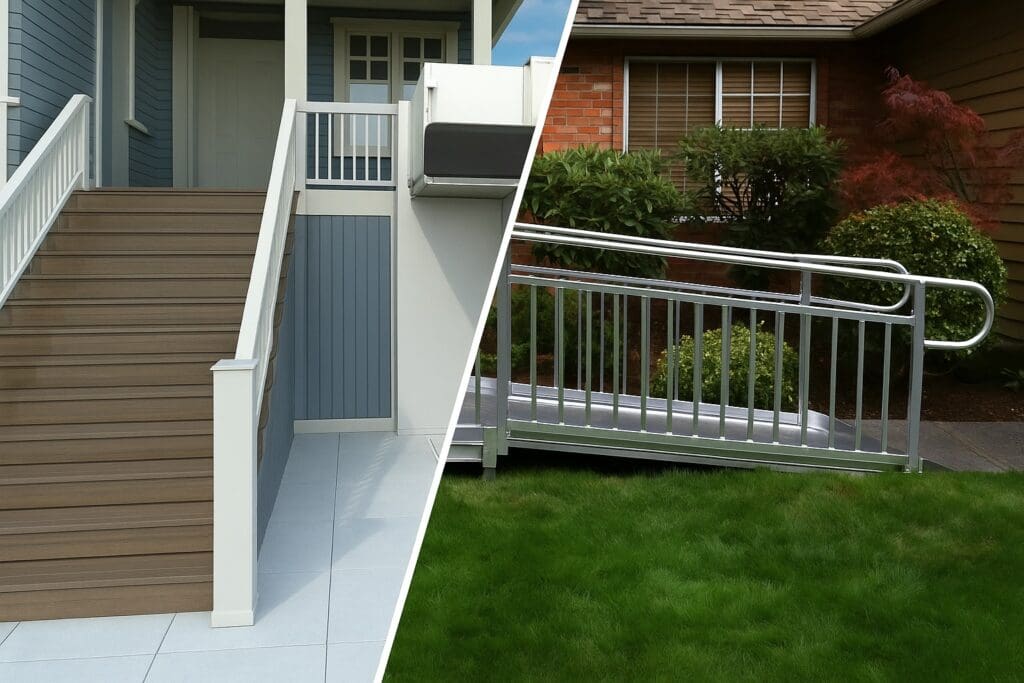Deciding between a wheelchair ramp and a vertical platform lift (VPL) is a key step when making a home accessible. Each option has benefits and trade-offs. The right choice depends on your lot, elevation, budget, and long-term goals. Below, we compare both options to help you know when a lift outperforms a ramp.
Understanding Your Starting Point
The Americans with Disabilities Act (ADA) recognizes that accessible routes can include ramps, lifts, or elevators. In residential settings, ramps are often the default—but when they become unfeasible, a vertical lift can fill the gap.
A good rule: when a ramp would require too much horizontal space or a steep incline, a VPL often becomes the better option.
What Is a Vertical Platform Lift (VPL)?
A vertical platform lift raises or lowers a mobility device (wheelchair, scooter) in a straight vertical motion between levels. It’s often installed next to stair landings or porches. The user rolls onto a platform, presses a button, and the lift carries them up or down.
Bruno’s platform lifts, for example, can handle up to 750 lb capacity and travel heights up to 10 feet in residential configurations. To prevent rollback, the ramp folds as the lift rises and optionally includes gates for added safety.
VPLs are essentially “mini elevators” without the vertical shaft or full elevator structure.
Key Factors to Evaluate
Here are the criteria that commonly tip the balance in favor of one solution over the other:
1. Available Horizontal Space (Footprint)
- Ramp: Must follow a maximum slope of 1:12 (1 inch of rise per 1 foot of run). So a 24-inch rise needs a 24-foot run, plus landings and clearance.
- VPL: Requires much less horizontal space. You mainly need platform landing zones.
When a ramp would crowd your patio, yard, driveway, or walkway, a VPL often becomes the smarter choice.
2. Rise (Height to Overcome)
- For small steps or single-level elevation (<24–36″), ramping is often manageable.
- Once elevation grows (deck, raised porch, multi-level rooms), ramps become long, costly, and prone to maintenance. That’s where VPLs shine.
3. Cost & Installation Complexity
- Ramp: For larger ramps, the base cost could be relatively low, but material, labor, permits, grading, and long-term maintenance add up quickly.
- VPL: A typical professionally installed platform lift often ranges between $6,000 to $35,000, depending on rise, site prep, options, and customization. Electrical wiring, concrete pads, permitting, and structural support can influence the final number but it’s always best to let us do a site visit so we can give you an accurate estimate..
In many cases, when you factor ramp length and complexities, a lift becomes cost-competitive.
4. User Comfort & Safety
- On a ramp, users may need strength or motorized help, especially if the slope is steep.
- A lift means the user stays stationary and the device does the work. It often feels safer for users with limited stamina or balance concerns.
5. Maintenance & Durability
- Ramp: Exposure to weather accelerates wear. Wood ramps may rot, and steel ramps may corrode. Snow removal and ongoing upkeep become necessary.
- VPL: Requires periodic mechanical inspections and upkeep, but the core structure, motor, and controls are protected and built for usage.
6. Aesthetic & Property Impact
Long ramps can dominate a yard or disrupt landscaping. A vertical lift tends to have a smaller footprint and preserve the character of your home.
When Might Someone Prefer a VPL to a Ramp?
Here are real-world situations where a vertical platform lift is often the better solution:
- Your property doesn’t allow for a long ramp without encroaching on other features
- You need to rise two or more levels
- You want minimal impact on your yard, design, or entry aesthetics
- You need a smooth, low-effort path for users with limited strength
- You prefer fewer ongoing maintenance tasks compared to a ramp
Comparing Lifetimes & ROI
Ramps, especially wood or steel builds, may need repair or replacement every 10–20 years depending on climate and use. A well-installed VPL, with maintenance, can last decades and often carries longer warranties or service plans.
When comparing costs, it’s wise to consider total lifetime cost—initial investment, maintenance, repair, and usability over time.
Installation & Compliance Considerations
- VPLs usually require a concrete pad, clear space, and a landing area
- Electrical wiring must reach the unit
- Permitting may be required, depending on local building codes
- For public or commercial usage, lifts must follow ASME A18.1 design standards
- Ensure the lift meets accessibility codes for gates, safety interlocks, sensors, and emergency stops
Final Comparison: Ramp vs Vertical Platform Lift
|
Feature |
Ramp |
Vertical Platform Lift |
|
Requires horizontal space |
High |
Medium–Low |
|
Suitable rise |
Low to moderate |
Moderate to high |
|
Initial cost |
Lower (for short length) |
Higher |
|
Maintenance needs |
High |
Moderate |
|
User effort |
Requires uphill movement |
Lift handles user movement |
|
Property impact |
Visually dominant |
Compact footprint |
|
Longevity |
Dependent on materials & weather |
Long, with upkeep |
If your elevation is modest and space is plentiful, a ramp may be sufficient. But when space, height, ease, or aesthetics matter, a vertical platform lift is often the smarter, more sustainable choice.
At All American Mobility, we evaluate your site, user needs, and budget to recommend the best fit. Contact us for a free accessibility assessment and see whether a ramp or lift works better for your home.

